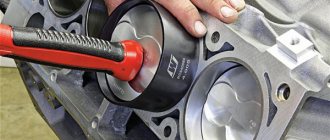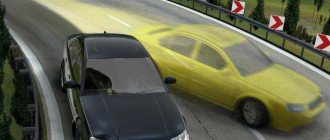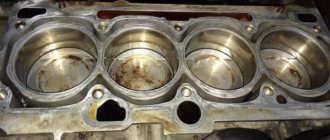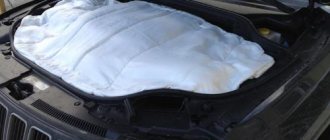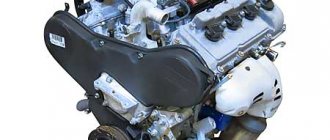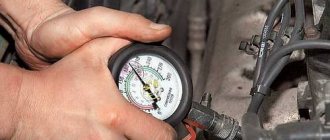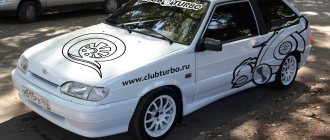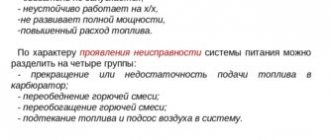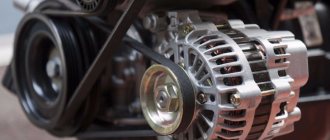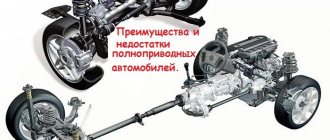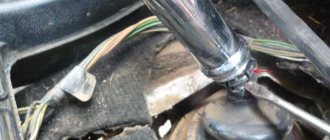Torque is not power
The power capabilities of power units have been assessed since the very moment when the first self-propelled mechanisms appeared. But power allows us to only partially characterize the traction force of a particular motor.
This is easily noticeable on internal combustion engines of the same class. So, on different cars you can observe that the dynamic characteristics may vary. That is, one car behaves quite quickly at low speeds, while on the other, in order to achieve the same effect, you need to spin the flywheel to almost maximum speed.
What is car engine torque?
Scientifically speaking, this is a physical quantity. This is the product of the force that is applied to a lever 1 m long and the distance from the axis in which this lever rotates to the point where the force is applied.
In the school physics course this quantity was called “moment of force”, and in mechanics courses it was called “torque”. This force is measured in Newtons per meter.
Engine torque is a value that shows the traction force of the unit. The more torque that goes from the engine to the wheels, the better and the more weight this engine can move, and the more acceleration this car can develop. Thus, trucks, tractors, various bulldozers, sports cars really need motors with high torque.
But this force that comes from the engine to the wheels does not even depend on the characteristics of the engine. To a greater extent, the dependence here is on the transmission gear ratios. So, the higher the gear ratios, the more torque will be delivered to the wheels at engine speeds. Such a machine will have higher dynamic characteristics.
Why is Nm more important than power?
An equally significant indicator when determining the performance of a power unit is its power. If we move away from abstruse terms and speak in simple words, then this figure demonstrates the number of completed torques over a certain period of time. In other words, the higher the power, the higher the maximum speed of the car. In the world, this indicator is measured in kW (kilowatts), but in our country we are used to focusing on horsepower. For comparison, 1 l. With. equals 735. kW.
All characteristics of the power unit declared by the manufacturer certainly intersect with the torque value, which once again emphasizes the importance of the parameter. In fact, the role of power is slightly exaggerated; it is only a derivative of torque. In order to verify the huge dependence of the first value on the second, it is enough to apply the simple formula P (power) = M (torque) * n (crankshaft revolutions per minute).
Look, to get moving, the car uses only part of its power; to reach its optimal level, a certain amount of time is required; many car companies indicate exactly how much time in the engine characteristics. So, the most important thing is how quickly the car reaches the power threshold depends on the torque. Judge for yourself which of the indicators is more important, but many experts, and even your humble servant, are confident that the power is noticeably inferior to its competitor.
Where and how is the moment born?
In order to find out where this phenomenon comes from, you need to remember the operating principle of the internal combustion engine. There is no need to consider the entire process, let's look at the cylinders.
At the beginning of the cycle, fuel is injected into the cylinder cavity. The piston then rises and the air/fuel mixture is compressed. After this, the spark plug comes into play. With the help of a spark, the mixture ignites and then expands. The piston moves down and causes the crankshaft to rotate.
When the driver presses the accelerator pedal, the volume of the injected mixture increases and the piston moves faster. Naturally, the crankshaft will also rotate at higher speeds. This is how the engine torque appears.
Where does it originate?
By pressing the gas pedal, the speed of the piston increases, and accordingly the speed of the crankshaft, which helps to increase speed and torque.
In more detail, this process consists of several stages:
- Mixed with the air necessary for the subsequent ignition of the liquid, fuel (diesel fuel or gasoline) is injected into the cylinder. Compressing the volume of the mixture trapped inside, the piston rises to the top of the cylinder from the bottom.
- The compressed fuel-air mixture is ignited by a spark supplied by the spark plug, which heats the fuel and air. The piston begins to fall down the cylinder, under the influence of the expanded mixture from heating.
- The crankshaft is driven by the movement of the piston, which pushes the connecting rod. The movement of the piston (back and forth) is equal to one revolution of the crankshaft around itself.
- This is what the torque effect looks like. The higher the pressure on the gas piston, the compression ratio of the fuel-air mixture, and the engine displacement, the higher the vehicle’s torque.
The force (gain) that is developed by a car engine is called torque, depending on the engine displacement.
The power of a machine depends on the size of its engine.
Engine power is a quantity that characterizes the operation of the engine for a certain amount of time. The greater the power, the correspondingly greater the speed.
Comparing these two indicators, the following points can be highlighted:
- Engine power is a derivative of torque.
- The engine power depends on the crankshaft rotation speed.
- When choosing a car, you should pay attention not only to power, but also to torque, which has an advantage over this value.
- The dynamics of vehicle acceleration, as well as the ability to quickly overcome hills, depend on the maximum torque value.
What depends on the magnitude of the torque?
The maximum speed depends on the dynamic characteristics. If the engine produces better dynamics, then it can reach maximum speed faster. The acceleration process is mostly affected only by power. This is a constant force, it can be adjusted by revolutions. More revs means more power. At what speed the car will gain momentum depends on the number of these same revolutions.
But the speed at which the unit picks up speed completely depends on the torque. And the engine torque itself depends on the number of revolutions.
Torque Calculation Formula
First, let's look at the formula for calculating power:
P(power, kW) = M(torque, Nm) x n (rpm) / 9550.
The calculation of KM is as follows:
M(torque, Nm) = P(power, kW) x 9550 / n (rpm).
In order to calculate the required values and not get confused, it is enough to use a converter, which is available on many car enthusiast sites.
How to calculate this value?
For these purposes, there is a formula from a physics course. This is Mkr = F * L, where F is the force with which the crankshaft rotates, and L is the length of the arm.
But it is quite difficult to perform accurate calculations using this formula. The force of rotation of the crankshaft is not constant. When the piston moves downward, there is free space in the cylinder and the force acting on the piston loses power.
Therefore, in order to calculate engine torque, the formula gives only approximate values. The moment is easier to determine by the number of engine revolutions. But don't think that it will be constant with the speed. This force tends to increase with rpm, and when the rpm reaches its peak threshold, the torque drops off. This can be easily noticed if you accelerate the car.
Every driver has noticed that at the start the car accelerates more slowly, but after a while the speed at which the car accelerates increases. Then after a while it decreases again.
Easy to understand transcript
To understand what the torque of a car engine is in simple words, it is important to differentiate it for yourself and the designation of power. In the latter case, power is usually understood as work obtained per minute, which everyone knows from a physics course.
A gasoline or diesel power plant consumes liquid fuel and converts the resulting thermal energy into kinetic form after combustion. During the process, work is performed, as a result of which the rotation of the crankshaft is ensured. A new indicator arises that characterizes the crankshaft rotation speed per unit of time, for example, revolutions per minute.
You need to know that the work performed by the internal combustion engine depends on the engine speed, and the dependence is directly proportional.
In the case of torque, the relationships between the main process indicators turn out to be somewhat different. The resulting value is largely manifested as a product between the available arm leverage and the force generated by the motor. The latter is formed during the process of fuel combustion and providing load on the working part of the piston, pushing the crankshaft. Force is traditionally measured in Newtons, and dimensions are usually measured in meters; the calculation takes into account the length from the axis to the load point on the crankshaft crank assembly, which makes it possible to measure torque in “newton-meters (N*m)”.
In fact, the concept of torque refers to the force that can be developed by a specific motor. Thanks to this, it is possible to determine the high-torque nature of the car, which contributes to a rapid increase in speed and further movement. Considering the pattern where the graph shows the dependence of engine torque, it should be noted that the desired parameter is responsible for the “agility” of the vehicle and dynamic characteristics. It is important to note that the force generated during the combustion of gasoline will increase with increasing cylinder volume; accordingly, this parameter is directly dependent on KM .
Power and torque
Power is measured in horsepower. However, in most average cars, all the power will be used only at maximum speed. In the city at 2000 rpm. the engine will be able to use only half of the “herd”. The unit will show its full strength only when overtaking at high speeds. Moreover, the more the torque increases, the faster the speed increases. There is a relationship between torque and connecting rod length. Longer connecting rod means stronger torque.
When the engine produces maximum power at 6000 rpm, acceleration requires raising the speed from 2000 rpm. This requires a certain amount of time, which is very important when overtaking. In the case of a motor with high torque, maximum power may appear already at 2000 rpm.
Such motors include the majority with low volumes. The torque of a diesel engine is also higher than that of a gasoline engine, even at lower power and low speeds.
It is those who own such cars who write on forums that strength is not in power, but in moment.
A torque of 200 Nm at low revs will be significantly better than the same torque at 4000 rpm. The best option is a motor in which the torque values will be practically peak throughout the entire speed range. But it costs a lot.
Diesel or gasoline?
Knowing what engine torque is, you can compare gasoline internal combustion engines and diesel engines. So, the torque in an internal combustion engine running on gasoline is small, and it can be achieved at 3000 rpm. However, such motors easily reach maximum speed.
Diesel engines do not like high speeds, often the maximum is 5000 rpm. But the torque of diesel engines is much higher, and it can be used even at idle.
For example, you can take two 2-liter units. The first is a 140 hp diesel engine. and 320 Nm of torque and an injection engine of 150 hp. The rated torque of the engine will be 200 Nm. Even without testing, the difference in torque is visible at a minimum number of revolutions.
If you test both units, then the diesel is already at 1-4 thousand rpm. will show power 40 hp higher. This is a serious difference.
No need to trust high power. The moment is also important when choosing a car. High torque means high dynamic performance. Also, high torque at low speeds saves fuel.
For example, the torque of VAZ engines is achieved already at medium speeds, and allows these cars to feel confident in city conditions.
How is torque measured?
To do this, just look at the technical documentation of your car. But real measurements are also available: special sensors must be used. They will allow for static and dynamic measurements.
The measurement consists of creating a situation where the engine reaches maximum speed, then brakes: the process creates a graph showing the maximum torque of the motor at the moment the brake is applied. At first the indicator will be small, then there will be an increase, a peak and a decrease.
Service stations must be equipped with professional strain gauges: all measurements are processed by special software, and the results are displayed in the form of graphs. The main difficulty in measuring CM is to achieve high accuracy of readings. Outdated contact, lighting or induction strain gauges did not provide adequate efficiency, so currently meters are used in the form of a compact transmitter mounted on a shaft: it transmits data to a receiver device that provides data that does not require processing.
How to increase the torque?
If you need to improve the dynamics of your car, you can use several methods. This is an increase in volume, installation of supercharging, as well as changes in gas dynamics.
The engine displacement can be increased by replacing the crankshaft with a large eccentric or by boring the cylinders. Replacing a crankshaft often comes at a cost and can be difficult to find the right model.
It is much more profitable to bore the cylinders. The walls fully allow such an event. In this case, you can even get by with serial pistons. However, it is not a fact that such a replacement will be cheaper than replacing the crankshaft.
Additional boost can only be applied where a turbine is already installed. This method requires additional changes. You can change the boost by raising the bar to release the pressure. Also, along with this, it will be necessary to further improve the combustion chambers, change the cooling system, radiators, and air intakes.
You can get by with less radical chip tuning. Thus, by reflashing the electronic unit, it is quite possible to easily and simply change many important parameters and characteristics of the car.
Electric motors
We live in the modern world and are increasingly seeing the birth of new technologies. So, everyone who is interested in cars knows the company Tesla, which produces electric cars. A photo of their latest model is shown below.
It uses an asynchronous electric motor as a motor. And the torque of an asynchronous motor, depending on the model, ranges from 420 Nm to 600. These are huge numbers. With such technical characteristics, the existing engine can accelerate the car to 100 kilometers per hour in 6.5 seconds with a minimum configuration.
What is meant by this definition
Don’t be afraid, because no one will take away your car and license just because you don’t know what it is. At first glance, it will seem that all this relates to drifting, but in fact, torque is only something without which drifting is not possible, but the appearance of drifting has nothing to do with this.
Let's look at an interesting example . The car's passport states that it can move at a speed of 120 kilometers per hour. You accelerate to 90 without much difficulty, and then the car picks up speed very slowly. If you pay close attention to the speedometer and tachometer, you will notice one interesting feature: the engine operates most efficiently only in a certain speed range. For example, Russian Zhiguli cars produce maximum performance only at 3000-3500 rpm. Another example, when a car produces 6000 rpm, it will of course develop a very high speed, but, unfortunately, it will take a very long time to gain it. This is especially bad for those who are stuck in a traffic jam, since the car moves very, very “tightly”.
This is where this engine parameter is crucial. It is measured in newtons on meters. The higher this parameter, the faster the car accelerates and reaches its maximum speed . However, the damage in this case is the speed itself, which is very limited.
Thus, as soon as the revolutions reach this very maximum value, the car will move much faster and accelerate in a shorter period of time. All this depends on the engine itself, or more precisely, on such important parameters as displacement or the presence of special turbochargers. The power indicator depends on this.
However, you should not focus only on this parameter. The fact is that if you arrange a race for two cars with the same volume, weight and torque, then it is likely that only one will come to the finish line first. The point here is not in the driver, but in the elasticity of the engine itself. Elasticity refers to the ratio of power, revolutions and torque . It is very important for fast driving that the last indicator be the highest. Thus, the engine will respond more widely to pressing the gas pedal, and it is not necessary to change gears. Any engine that has such parameters will definitely make the car owner an object of envy, because only he will get real pleasure from driving the car.
Of course, gasoline engines are far ahead of diesel in this regard. Indeed, for such engines it is typical to obtain the maximum value of this value at 3000 rpm, and for a diesel engine this moment begins only after 4000.
As you can see, understanding this term was not at all difficult and it is far from the last. Once you understand this, you can easily understand the intricacies of these quantities and get maximum performance from your motor. We wish you good luck on the roads!
Summarizing
So, we know what the torque of an internal combustion engine is. If the power of the units helps increase car sales, then the torque helps the car move forward.
But power and torque are related. Power is the amount of work, and torque is the ability of the engine to perform such work. This is the resistance that the unit needs to overcome.
That's what torque really is. This is an important characteristic paired with power.
